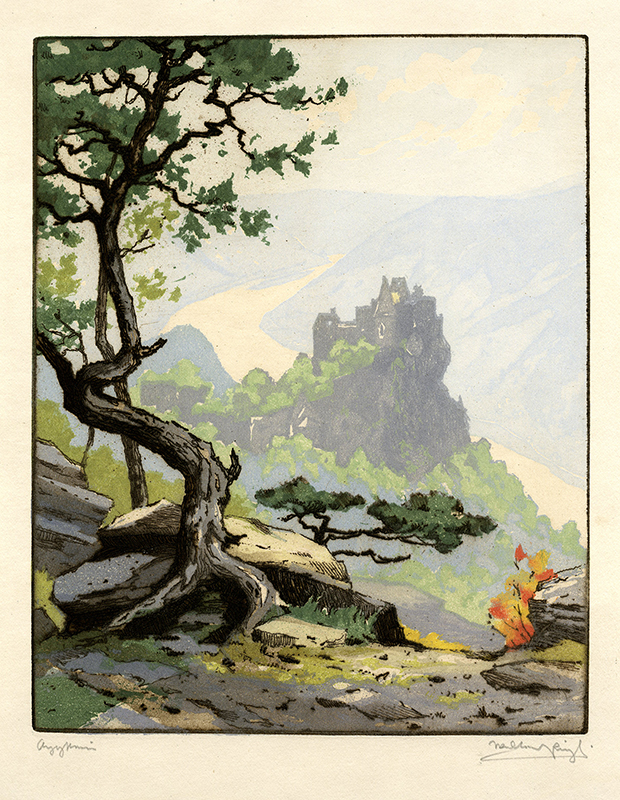Aggstein is an etching and color aquatint from about 1930 by Austrian artist Walter Prinzl. It is pencil signed and inscribed Aggstein. It was printed by the artist on a sheet of ivory wove paper and the platemark measures 11 x 8-13/16".
Walter Prinzl’s subjects were often romantic and his etchings and color aquatints often required two or three plates for printing the colors. His etching and color aquatint, Aggstein, depicts the ruins of the Aggstein castle, located on the right bank of the Danube River in Wachau, Austria. The castle is situated about 980 feet above the right bank of the Danube (seen in the distance) on an outcrop running from east to west. It is some 490 feet long and has a rock structure at both ends. The castle traces its origins to the beginning of the 12th century when it was built by Manegold III of Acchispach (Aggsbach). The castle had a colorful history of sieges, robber barons, and nobles. It was destroyed by the Turks in 1529 and never regained its earlier glory. Today the castle is one of the most popular tourists attractions in lower Austria.
Walter Prinzl, painter, frescoist, printmaker, and book illustrator, was born in Vienna, Austria on 29 September 1891 to Anton and Maria Prinzl. He was raised in Melk, Austria and first studied architecture at the Technical University in Vienna. Between the years 1908 and 1912, Prinzl studied etching and engraving at the Graphische Lehr- und Versuchsanstalt (Graphic Arts and Research Institute). In 1911, he became a member of the Vienna academic fraternity Teutonia. After serving in World War I, Prinzl decided on a career as an artist rather than an architect and returned to the Graphische Lehr- und Versuchsanstalt attending general painting classes under Hans Tichy between 1921 and 1923.
After the completion of his studies and his marriage to Nina Guzmann, Prinzl purchased an old city stone tower which he converted into his studio where he set up his printing press. In the 1930s, he was considered one of the most successful Austrian artists. He traveled extensively throughout Austria, Czechoslovakia, Germany, and Italy recording the landscapes and cityscapes in drawing and watercolor which he would later translate into etchings. Two of his color etchings were included among mostly paintings in the XIV Exhibition of the Klosterneuburger Künstlerbundes in 1930.
A versatile artist, Prinzl worked in etching and woodcut, and painted portraits and frescoes. He returned to his architectural roots to draw plans to refurbish old buildings and was a consultant in the field of monument protection, and he illustrated Sagen der Wachau by Hans Plöckinger. Unfortunately, most of his frescoes no longer exist due to weather, modernization, or badly handled restoration.
Prinzl died in Vienna on 12 December 1937, after a brief hospital stay, at the age of forty-seven years.



